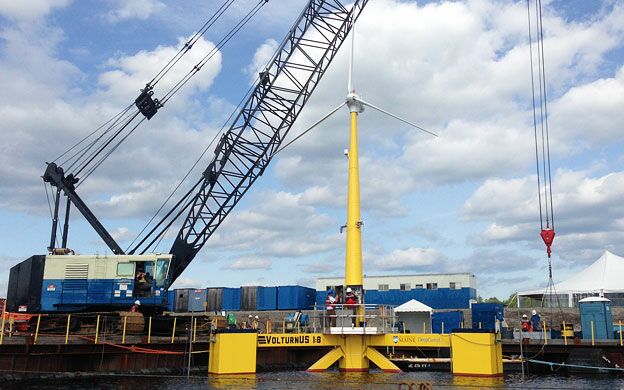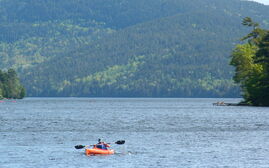Offshore wind consortium releases redacted proposal
 Courtesy Cianbro
The UMaine-led consortium working on a floating offshore wind turbine design, called VolturnUS, today released a redacted report detailing its plans for a 12 megawatt pilot project in the Gulf of Maine.
Courtesy Cianbro
The UMaine-led consortium working on a floating offshore wind turbine design, called VolturnUS, today released a redacted report detailing its plans for a 12 megawatt pilot project in the Gulf of Maine.
The University of Maine-led offshore wind project, Maine Aqua Ventus I, has released hundreds of documents about the scope of its proposal to state regulators, but the questions of how much the project will cost and how much support it hopes to get from electricity ratepayers remain unanswered for now.
Jake Ward, who manages the project in his role as the University of Maine’s vice president for innovation and economic development, told Mainebiz those details will likely emerge Nov. 15 in a term sheet negotiated with the Maine Public Utilities Commission.
While those topics remain under lock and key, the ream of documents released today in response to a PUC vote reveals a full list of the companies involved in the project, a look at the UMaine-led consortium’s plans for gathering data about a test site near Castine and a closer look at the floating turbine technology that leaders of the project think will have an edge in competing for one of three $46.6 million federal grants that would move the project closer to developing a commercial-scale offshore wind farm. There are six projects, including Aqua Ventus, competing for the next round of funding from the U.S. Department of Energy.
Jeffrey Thaler, an attorney representing the university on the project, said the only other floating offshore wind structure is proposed by the Oregon-based Principle Power. Regarding the competing wind projects that use a structure fixed to the ocean floor, Ward said the Maine project can be deployed in a wider range of water depths, including shallow water applications.
Ward said that design aspect will allow the Aqua Ventus turbine to be deployed closer to various load centers that stand to benefit from adding offshore wind generation to the power grid. If the project does not advance in the next round of DOE grants, Ward said the consortium would seek other financing and perhaps other ways than its 12 megawatt pilot project to prove the viability of a full-scale commercial wind farm with a capacity of up to 500 megawatts.
The Aqua Ventus project, which has the companies Cianbro and Emera as primary collaborators, is the only offshore wind project in Maine vying for federal money to support new energy technologies. The Norwegian company Statoil had filed a proposal and negotiated a term sheet with the PUC but decided to scuttle its Maine project after the Legislature voted to allow Aqua Ventus to bid for pilot project status, meaning the project could receive some level of ratepayer support for developing its new technology.
Clarification: A previous version of this story misstated Jake Ward's comparison of the Aqua Ventus project to its other floating offshore wind competitor, Principle Power, in Oregon.














Comments